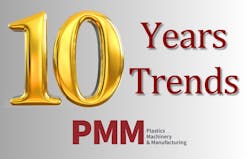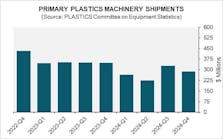As Plastics Machinery & Manufacturing marks its 10th anniversary, the staff is looking back on the events and issues that shaped our coverage over our first decade.
By Karen Hanna
Wanted: A manufacturing team member “responsible for setting up, operating, monitoring, and adjusting multi-axis CNC milling/grinding/lathe, injection molding, induction, multiple grinders, or other ... equipment.”
The ad, available on LinkedIn since early October, had attracted just one potential application by the middle of the month, according to the job board. While it was posted by a company in Mansfield, Texas, the need is national — the Manufacturing Institute has projected that between 1.9 million and 2.1 million manufacturing jobs could go unfilled over about the next decade.
Job shortages hamstrung many industries — including plastics processing — in the wake of the COVID-19 pandemic, but problems could persist for the next several years as the last of the bubble of baby boomers retires, and members of younger, mostly smaller, generations take their place. According to the U.S. Census Bureau, in July 2023, there were 131.1 million people living in the U.S. between the ages of 20 and 49; meanwhile, the number of people aged 50-69 — at an age they have retired or could be moving toward doing so — was 81.6 million — about the same as the number of youths aged 18 and younger.
According to the U.S. Bureau of Labor Statistics (BLS), the rate of people in the population who are working and looking for work fell sharply early in the pandemic, when companies raced to adopt work-from-home or social distancing protocols. Among people 18 and older, it was 64.4 percent in November 2014, but only 61.4 percent in April 2020; as of August, it stood at 64 percent. The number of manufacturing job openings was 327,000 in November 2014, but exploded during the pandemic as employers struggled to find workers — it hit 997,000 in April 2022.
“The manufacturing industry as a whole faced a major setback after losing roughly 1.4 million jobs during the onset of the pandemic. Since then, the industry has made significant strides toward recovery, making a concerted effort to address job vacancies,” the U.S. Chamber of Commerce reports.
As of August, the number of manufacturing job openings was down to 506,000, according to the BLS.
The number of job openings would represent almost 3.2 percent of all manufacturing jobs if they were filled.
Considering that the overall the number of unfilled jobs stood at 8 million in August, with 7.1 million looking for work, you might need to keep your job postings at the ready — hiring could continue to be competitive.
Karen Hanna | Senior Staff Reporter
Senior Staff Reporter Karen Hanna covers injection molding, molds and tooling, processors, workforce and other topics, and writes features including In Other Words and Problem Solved for Plastics Machinery & Manufacturing, Plastics Recycling and The Journal of Blow Molding. She has more than 15 years of experience in daily and magazine journalism.







